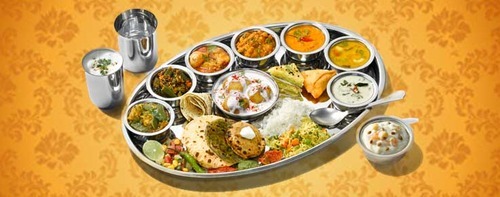Thali – India on a plate
by Jenny Jonson WriterFood has a special meaning in people’s lives all over the world. The presentation, nutritional value, spices involved and method of eating and serving are significantly different among a variety of cuisines originating from various parts of the world. Just as food served in European and western countries comprises of different courses, the thali is considered as the perfect meal in various parts of India. This form of Indian cuisine is rich in nourishment and has its roots from ancient Ayurveda.

The concept of a balanced meal has been incorporated in Indian
culture since the ancient Vedic times. Ayurveda specifies six tastes –
astringent, bitter, pungent, sweet, sour and salty. These six tastes
must be included in every meal so as to get a balance of all essential
nutrients required by the human body. Traditional food from various
parts of India considers these six tastes to be very important while
preparing meals.
The way food is perceived in an Indian household
holds great importance. The food is generally cooked by the women in
the household and served on a thali or plate. This consists of a variety
of home cooked vegetables and bread coupled with rice which serve as a
part of the balanced meal.
Restaurants have been trying to
compete with Indian women in terms of cooking healthy and nutritious
food since a long time. But ordering food in restaurants becomes more of
a choice in terms of taste rather than health. Even if Indian traditional food
is ordered, every dish might not have all the nutrients that the body
requires. This in turn causes restaurants to become more popular in
terms of a luxury rather than health and nutrition.
To overcome
this challenge, restaurants have brought Ayurveda into their kitchens.
The six tastes that were mentioned in the previous paragraphs are
stimulated in one’s palate in the form of an organized set of elements
of food arranged on a plate. This basically creates a ‘thali’ of the
various elements.
Scientifically, the purpose of including
Ayurveda in one’s palate is mainly to ensure all essential nutrients are
received by the body. There are certain basic elements of food that are
included in a thali.
• Vegetables – These are seasonally
prepared with various spices and served dry or in gravy. They are a rich
source of vitamins and minerals. A combination of vegetables ensures a
variety of vitamins and minerals consumed by the individual.
• Rice – Rice is the main source of carbohydrates.
• Indian bread – Made up of wheat primarily, it is source of protein and carbohydrates.
• Lentils/Pulses – They are a rich source of proteins.
•
Pickles – It acts as a supplement of salt, minerals & vitamins and
is made up of almost all fruits and vegetables – Mango, Lime, Chilly,
Ginger, Carrot, Tamarind, Gooseberry to name a few.
• Side Dishes – Various side dishes are incorporated. Salads are also used.
• Sweets – These are an essential part of any Indian meal. Sweets supply sugar for the hot climate of India.
It
is said that apart from the meal itself, the way in which the items are
organized on the plate optimizes digestion. The earliest versions of
the thali
can be seen in the form of broad banana leaves and organic dishes made
from leaves. These were majorly used in festivals, rituals and weddings
so as to dispose them easily. Some restaurants today serve with a
bottomless refill system with the idea being that one can eat until they
are fully satisfied. In large gatherings, it is considered a social
faux pas to refuse any elements of food. Refills however can be refused.
Sponsor Ads
Created on Dec 31st 1969 18:00. Viewed 0 times.



